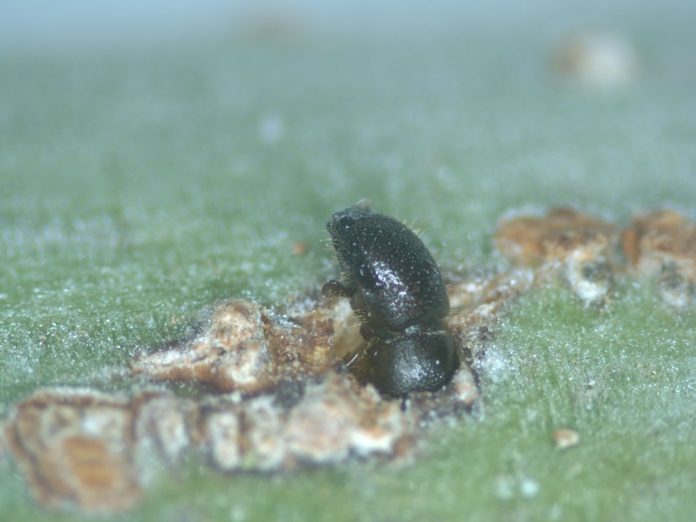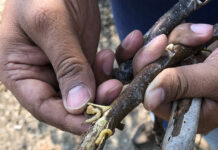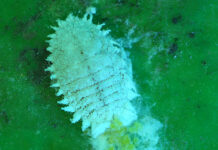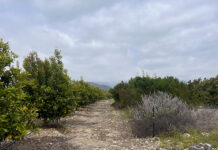Globally, invasive insect pests cause substantial damage to agricultural crops and natural environments. In the U.S. alone, crop and forest production losses from invasive insects and pathogens have been estimated at almost $40 billion per year (Pimentel et al. 2005). On average, a new non-native invertebrate is introduced into California every 40 days. With respect to insects and mites, about one-third of these become pests (Dowell et al. 2016), and economic losses in California are estimated at more than $3 billion per year (Metcalf 1995).
Rapid growth of U.S. demand for fresh avocados has increased the fruit’s prominence in retail sales and diets. California is the largest producer of avocados grown in the U.S. The value of U.S. avocado production measured at approximately $392 million in 2017, (NASS, 2018). There are more than 3,000 avocado growers in the state farming on approximately 50,000 acres of land, with Ventura County leading the state in most acres planted and harvested in recent years (California Avocado Commission [CAC], 2020).
California avocados are particularly special because less than 1% of the state is suitable for growing them. A healthy, single ‘Hass’ avocado tree can produce up to 200 pounds of fresh fruit each year, which is ~500 pieces. In 2018 alone, California produced around 350 million pounds. Avocados are considered a specialty crop and are not cheap to grow because of water and land costs, and fruit therefore usually demands a high premium price.
Traditionally, insecticide use in California avocado orchards has been minimal due to relatively few pest species, which, for the most part, have been under adequate levels of biological control (Hoddle 2005). However, due to the increase of international trade, illegal importation and the smuggling of foliage, branches with leaves, whole plants and budwood, invasive insect and mite pests have begun to threaten the economic viability of avocado production in California.

Polyphagous and Kuroshio Shot Hole Borers
Polyphagous Shot Hole Bore (PSHB) is an invasive ambrosia beetle from Southeast Asia that was first detected in Los Angeles County in 2003 (Gomez et al. 2018, Rabaglia et al. 2006). PSHB is a pest of great concern in Southern California as it can attack over 300 tree species and reproduce on a subset of these that are capable of supporting beetle reproduction and growing the fungi that cause fusarium dieback.
PSHB has a strong symbiotic relationship with several fungi, including Fusarium euwallaceae and Fusarium kuroshium, the causal agent of Fusarium Dieback (FD) disease (Eskalen et al. 2013). The list of reproductive hosts includes several native oaks, maples, sycamores, willows and avocado. The fungus disrupts the vascular transport of water and nutrients on their host tree that eventually causes branch dieback. The most common symptoms of the disease include sugar or gum exudates, dieback, wilt and ultimately host tree mortality. Reports of dieback symptoms in El Cajon, San Diego County led to the discovery of another species, the Kuroshio shot hole borer (KSHB) in 2013.
KSHB is also present in commercial avocado orchards in San Diego County. KSHB was originally limited to the San Diego region but has since spread to Orange, Los Angeles, Ventura and Santa Barbara counties. Presumably, PSHB and KSHB were introduced accidentally into Southern California via wooden products and/or shipping material (e.g., pallets and dunnage) from Southeast Asia. KSHB is morphologically indistinguishable from PSHB, but species can be separated using molecular techniques.
The fungus gets into the woody tissue of the tree when a female PSHB excavates a gallery and inoculates the gallery walls with fungal spores that it carries in special structures called mycangia (Beaver, 1989). The female PSHB and her offspring feed exclusively on the fungal spores. PSHB adults engage in sibling mating within the natal gallery. Offspring sex ratios are female biased to maximize reproductive output such that one male can inseminate many of his female siblings. Once fully developed and mated, female PSHB exit their natal gallery to start a gallery of their own and repeat the cycle. Unlike their sisters, male PSHB do not disperse since they are not capable of flying and do not possess mycangia, which are specialized structures for fungus storage.
Pesticide efficacy may be limited, and this is attributed to the fact that PSHB feeds on fungi and not directly on wood tissue. This reduces exposure to active ingredients when feeding (Eatough Jones et al. 2017). Cultural management practices include: 1) removal of infected branches to reduce local beetle numbers and fungal spread in the infested area; 2) chipping (< 1 inch) and solarizing infested wood; and 3) avoiding movement of infested materials to new areas (if transportation of materials is necessary, it must be covered(UC IPM 2017).
These management strategies can perhaps abate the severity of local infestations. Also, limiting the spread of infected/infested trees include minimizing firewood transportation. Sterilizing pruning tools with household bleach or another cleaning solution can reduce the spread of the FD pathogen. The PSHB was found in Israel in 2009 in commercial avocado orchards where it damages trees. To date, there has been no avocado tree fatality due to the PSHB or FD in California. For more information regarding PSHB, visit ucanr.edu/sites/pshb/.
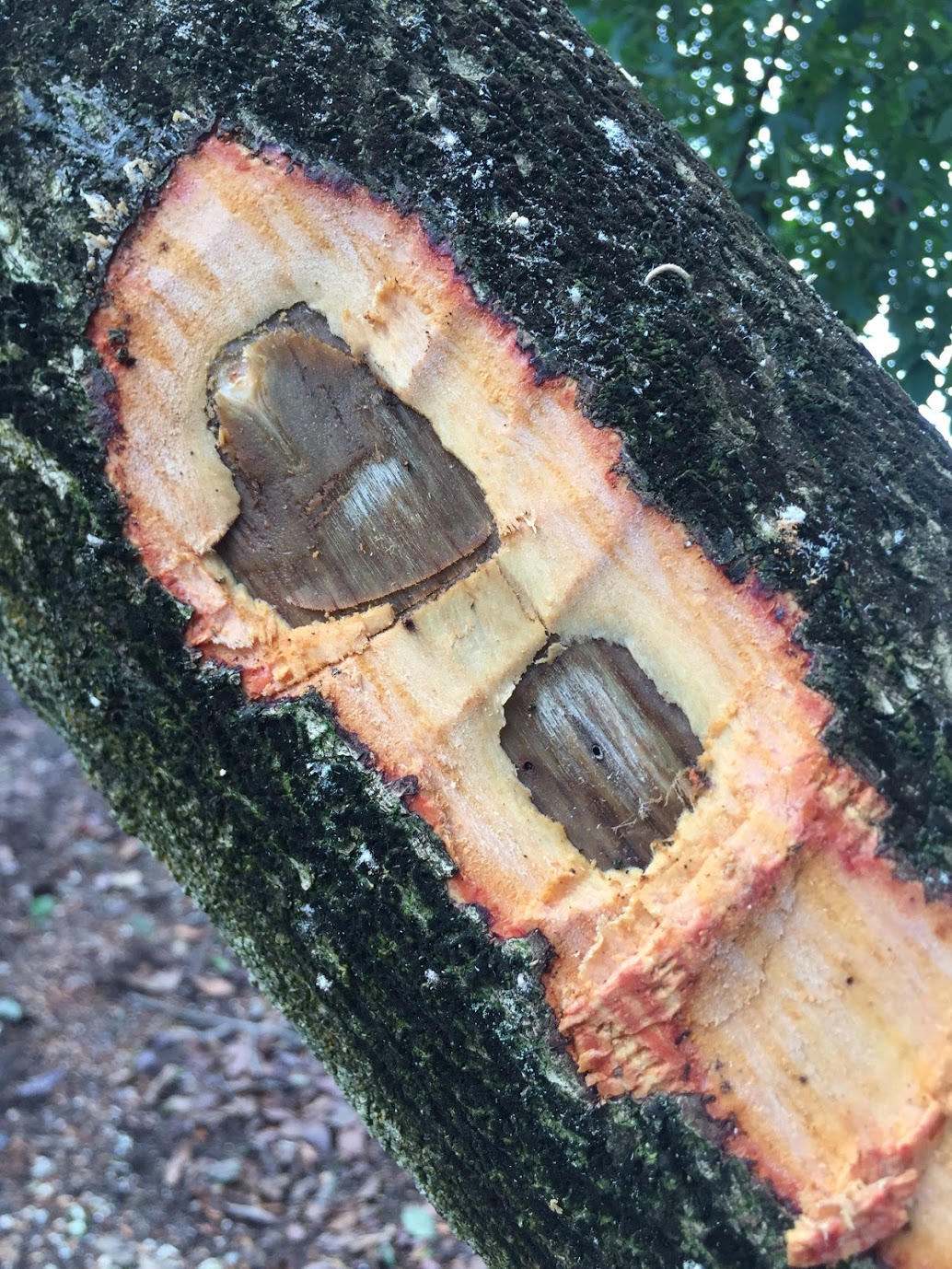
Redbay Ambrosia Beetle and Laurel Wilt Complex
An invasive ambrosia beetle, the redbay ambrosia beetle (RAB; Xyleborus glabratus) is a serious pest currently spreading through the Florida avocado industry and has been responsible for significant yield reductions since its discovery in 2005. The beetle was first detected in the U.S. in Port Wentworth, Ga. in 2002 and was probably introduced via infested wooden packaging material (Crane 2011).
This beetle has been slowly spreading across the southeastern U.S. and is currently found as far west as east Texas. Therefore, California growers need to be aware that this pest-disease complex may spread to California avocados. What makes this complex dangerous is that the vector, RAB, has a symbiotic relationship with the fungal pathogen Raffaelea lauricola that causes Laurel Wilt Disease (LWD). Native to Southeast Asia, RAB has similarities to our current ambrosia pest, PSHB. However, the fungus associated with LWD is unlike the disease here in California. Trees become infected when female beetles attack host trees and introduce the pathogen into the xylem while boring their galleries. The infection restricts the flow of water in the tree, induces a black discoloration in the outer sapwood and causes the leaves to wilt. Tree mortality is so rapid that leaves do not fall from dying branches.
Symptoms of RAB beetle and LWD infestations include (Carrillo et al. 2017):
- Wilting of leaves and young stems. You can usually see dead leaves hanging on branches.
Color change in leaves from light green to dark purplish green or greenish brown. - Stem and limb dieback.
- Trunk and major limbs that show dried sap which has a white appearance and is a crystalline, powder-like material.
- Dark streaks in the sapwood. Normally sapwood should be white to yellowish white in coloration with no dark staining or streaking. To check for this symptom simply remove a section of the bark to check for discoloration, which, if present, may indicate fungal infection.
- Small, dark holes in the sapwood and what looks like loose wood dust and frass indicate wood boring beetles are present.
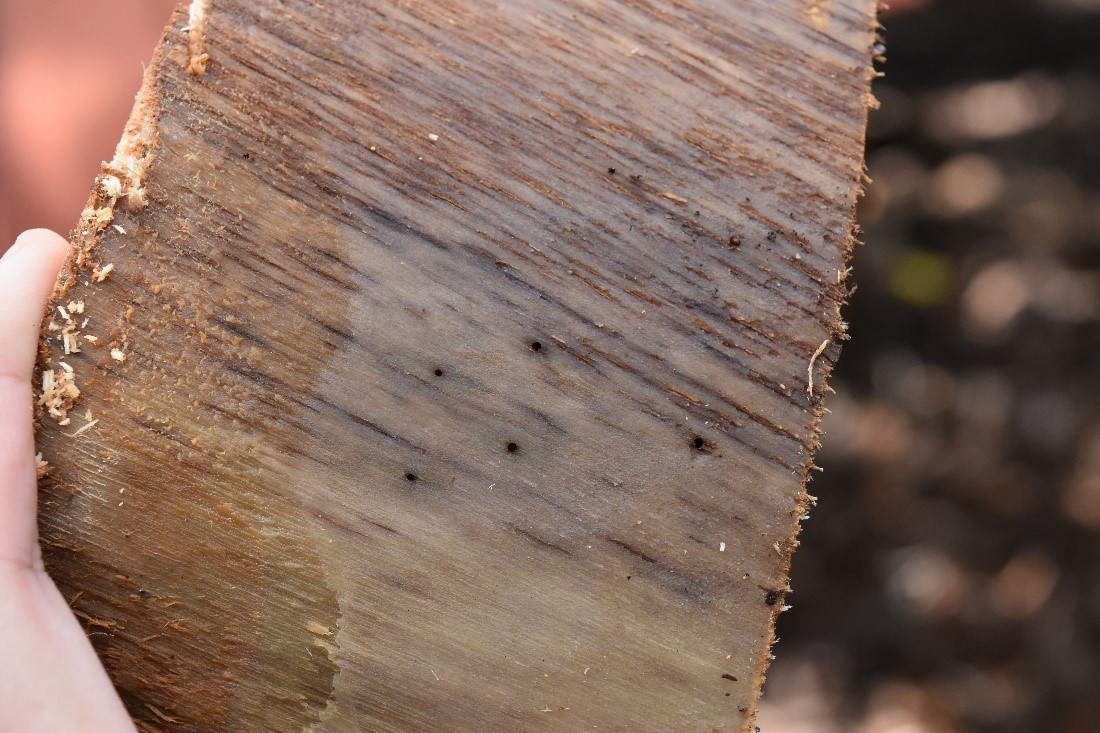
LWD affects redbay (Persea borbonia) and other tree species of the Laurel family (Lauraceae), including avocado. R. lauricola is introduced into host trees when adult RAB colonizes a tree. Adult RAB are very small (~1/16-inch-long), dark brown to black in color and spend most of their life within the tree. Larvae are white, legless grubs with an amber colored head capsule and are found within galleries throughout infected trees. Female beetles can produce flightless male offspring without mating, but females may mate with their male offspring or brothers to produce males and females. Females greatly outnumber males in populations. In the Southeast U.S., RAB’s lifecycle from egg to adult appears to take 50 to 60 days, and there appear to be multiple overlapping generations per year (Hanula et al. 2008). Female beetles emerging from galleries may reinfest the same tree or disperse in search of new hosts. Host trees can remain standing for years and may continue to serve as host material for beetles for several months after initial colonization. Flight activity peaks in the late afternoon and early evening.
It is known that ambrosia beetles are notoriously difficult to control with insecticides because they are protected from residues by living inside the tree most of their life versus being outside the tree. RAB can fly short distances, but LW fungus spreads more quickly through the movement of insect-infested plant material, such as firewood.
Additionally, the pathogen also spreads to other ambrosia beetle vectors. This happens when beetles feed on diseased trees and become contaminated with spores of R. lauricola. Spread can also occur through root grafting between trees. Sanitation is the most effective way to manage this problem. Scouting for wilted branches and quickly removing them has been key to successful early intervention and eradication.
It has been suggested to remove symptomatic trees immediately upon their identification. However, once the appearance of frass and streaks start to show in the wood, this is a sign that the tree has already been infected and has been for some time. As soon as a grower sees the wilt in the branches, it’s time to move quickly. Verticillium wilt and Phytophthora root rot can be mistaken for LW, so avocado growers should check for these diseases before removing trees.
The Florida avocado industry has implemented a universal detection and suppression program with the goal of preventing or limiting the incidence of LW in commercial groves and depressing ambrosia beetle populations (Carrillo et. al 2017). Surveying for the symptoms of LW is a key component to limiting the spread of the disease. Growers and their workers should survey groves weekly or more often if an infestation is detected in an adjacent grove. Early detection, removal and destruction of LW affected trees is the most important practice for controlling LW.
Contact insecticides are ineffective because the pathogen vectors (i.e., the ambrosia beetles) are primarily inside the tree. The first goal is to avoid infestation with the beetles by maintaining a healthy tree as stressed trees are more attractive to colonizing beetles. Beetles prefer trees in orchards that have dense canopies with overlapping leaves and branches.
Chipping infected trees is effective in reducing the spread of the disease. However, chips must be as small as possible (one square inch or smaller) and dried quickly so that the wood is not conducive to fungal growth. A potential drawback to this method is that the aroma of the chipped wood can attract other wood boring insects. Research in Florida is currently being conducted to determine if different commercial formulations of insecticides can be effective in controlling the beetle. For more information regarding LW and RAB, please visit sfyl.ifas.ufl.edu/miami-dade/agriculture/laurel-wilt—a-disease-impacting-avocados/.
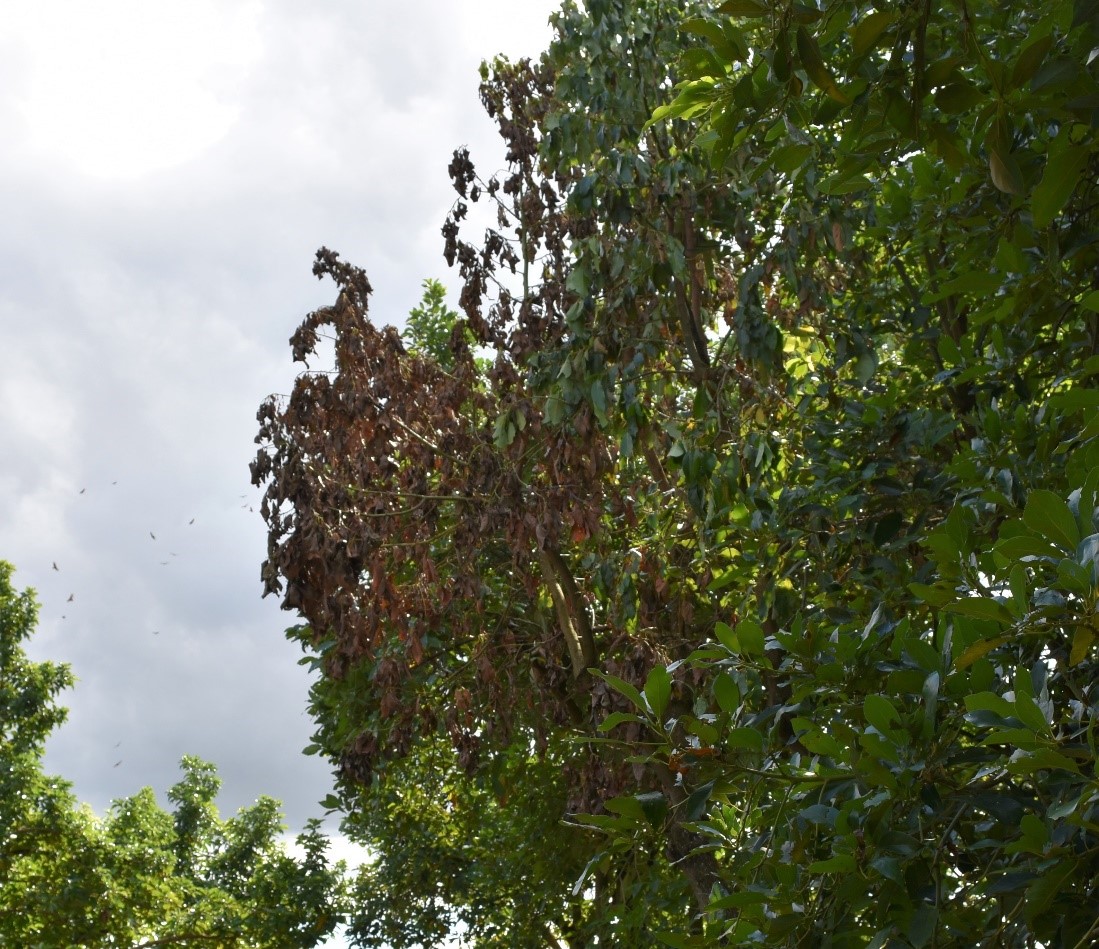
Avocado Lacebug
The avocado lacebug (ALB), Pseudacysta perseae (Hemiptera: Tingidae), was first detected in California on backyard avocado trees in Chula Vista and National City, San Diego County in 2004. This pest was first described in Florida in 1908 and has since been reported from Mexico, Guatemala, Puerto Rico, Jamaica, the Dominican Republic and parts of northeastern South America. The native range of ALB is uncertain. Molecular studies suggest that the western areas of Mexico may be the evolutionary center of origin for this pest and it was spread unintentionally from this area, probably on avocado trees into eastern Mexico, Florida and the Caribbean (Rugman-Jones et al. 2012).
After a lull of approximately 13 years, reports started coming of ALB damage to avocados outside of San Diego. In October 2017, well established, reproducing populations of lace bugs were confirmed in commercial Hass avocado groves in Oceanside and De Luz in San Diego County and in Temecula in Riverside County (CAC, 2017). Around this time, infestations were reported from backyard avocados in Culver City in Los Angeles County. Genetic analysis suggested that these new, more damaging populations of ALB were different to those originally detected in San Diego in 2004, and it’s likely that a second introduction of ALB into California has occurred, possibly from Florida (Rugman-Jones and Stouthamer unpublished molecular data).
ALB has been recorded feeding on avocado, red bay and camphor, which are all in the Lauraceae family.
Avocado lace bug is a true bug with sucking mouth parts. Lace bugs use these needle-like mouthparts to feed on the undersides of leaves. Through feeding, leaf cells and pierced cell contents are extracted and ingested, preventing photosynthesis.
Adult avocado lace bugs are small, winged insects, about 2 mm in length (slightly longer than 1/16 in), with black bodies, yellow legs and antennae, and are visible to the naked eye (UC IPM 2021). ALB live in colonies on the lower surfaces of mature leaves, often adults, eggs and nymphs are found together. Eggs are laid in an irregular pattern, sometimes in loose rows, attached to the lower leaf surface and are covered with irregular globules of a black, sticky, tar-like substance excreted by adults. To the naked eye, eggs will appear like grains of black pepper or dirt.
Eggs hatch into wingless nymphs that are capable of walking. Nymphs go through a gradual metamorphosis, shedding their exoskeleton several times as they grow in size, finally developing wings and becoming flying adults. Nymphs are dark red-brown to black and covered with spines. They feed for approximately two to three weeks before maturing into adult males and females which mate, and females then lay eggs, starting the cycle over. In California, ALB populations tend to peak over early summer, around June, then decline in fall, sometime around September (Humeres et al. 2009).
ALB restrict their feeding to the undersides of leaves. Feeding initially causes small white or yellow spots on the surface of the leaves as individual cells dry out. These necrotic areas look like tip-burn caused by excessive salts, but in this case, the necrotic areas are islands of dead tissue in the interior of the leaf surrounded by living tissue. It is suspected that feeding damage can provide entrance for pathogenic fungi, in particular Colletotrichum spp., which are leaf anthracnose fungi. As lace bug colonies grow, brown necrotic areas develop where there has been heavy feeding damage. Heavy feeding can cause striking leaf discoloration and early leaf drop (Hoddle 2004; Hoddle et al. 2005). Avocado lace bug nymphs and adults do not feed on fruit. However, heavy feeding damage to leaves will likely have a detrimental effect on yield, which may result from the loss of photosynthetic capacity in damaged leaves.
Relatively little is known about biology and ecology of ALB in California. In Florida, the most important biological control agents are two egg parasitoids including Oligosita sp. (a Trichogrammatid wasp) and an unidentified mymarid wasp. Green lace wing larvae and other generalist predators are also thought to be important natural enemies. A predatory thrips, Franklinothrips vespiformis, is reported to be the most important natural enemy of the avocado lace bug in the Dominican Republic and is similarly abundant on ALB-infested avocados in Escuintla Guatemala.
Insecticide treatments for other sucking pests currently registered for use on avocado in California will likely provide control of avocado lace bugs (Hoddle et al. 2005). In a trial reported in 1998, J. E. Peña, University of Florida (UF), showed that citrus oil, M-Pede (insecticidal soap) and Mycotrol (a Beauveria fungal species) all controlled lace bug, but it was not indicated how long the effect lasted. Researchers at UF have shown that citrus oil and M-Pede provided short-term lace bug control. Results of small tree trials or weathered residue tests have indicated that carbaryl, imidicloprid, cyfluthrin, carbaryl, fenpropathrin and malathion provide excellent control of avocado lace bug nymphs. Spinosad, abamectin and mineral oil are much less effective at providing control (Humeres et al. 2009b; Byrne et al. 2010). For more information on lace bugs, please visit biocontrol.ucr.edu/avocado-lace-bug.
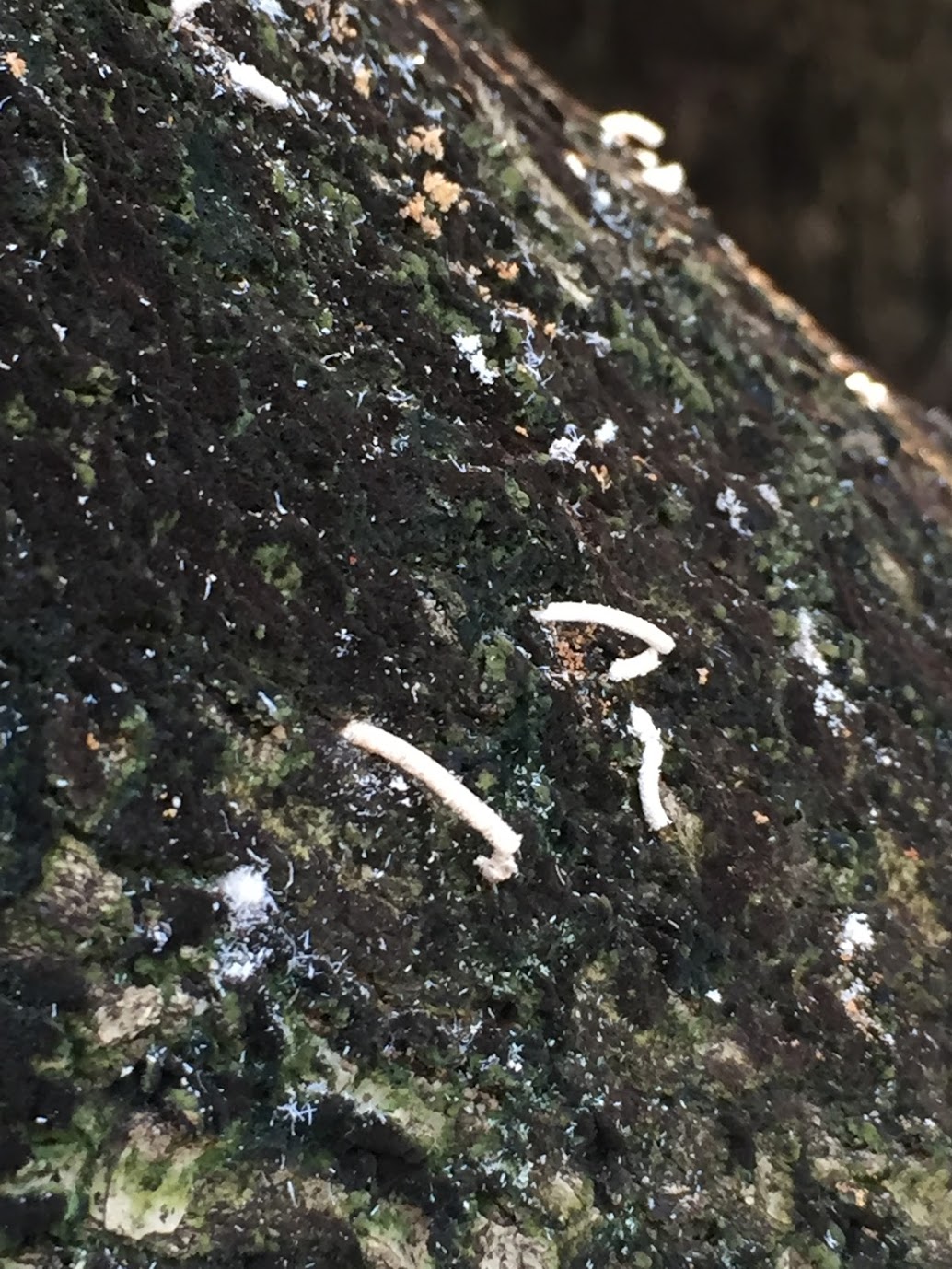
Proactive Management and Early Detection
The concept of early detection and rapid response is fundamental to effective invasive species management. Developing collaborative relationships with avocado research colleagues in different countries can provide insight into new potential pest problems that could eventually find their way to California (Hoddle et al. 2009). Developing this idea further can result in the development of proactive biological control and IPM programs in advance of the anticipated arrival of new pest species (Hoddle et al. 2018).
Ideally, finding a new pest species in the early stages of the invasion and quickly containing and treating the new infestation may reduce costly long-term management, especially if eradication is possible. Rapid and decisive containment actions are an important consideration as controlling invasive pests, especially fruit feeders, in California avocado orchards will always be a challenge and expensive should they establish widely.

References
Byrne, F. J., Almanzor, J., Tellez, I., Eskalen, A., Grosman, D. M., & Morse, J. G. 2020. Evaluation of trunk-injected emamectin benzoate as a potential management strategy for Kuroshio shot hole borer in avocado trees. Crop Protection, 132, 105136.
Byrne, F. J., Humeres, E. C., Urena, A. A., Hoddle, M. S., and Morse, J. G. 2010. Field evaluation of systemic imidacloprid for the management of avocado thrips and avocado lace bug in California avocado groves. Pest management science, 66(10), 1129-1136.
Carrillo, D., J. Crane, R. Ploetz, E. Evans, and J. Wasielewski. 2017. Brief Update to Laurel Wilt Recommendations – Ambrosia Beetles. Univ. of Florida, IFAS Extension Notice.
Crane, J. (2011) Laurel Wilt and the Redbay Ambrosia Beetle threaten Florida’s avocado and native trees in the Laurel Family. Univ. of Florida, IFAS Extension Homeowner informational brochure.
Coleman, T. W., Poloni, A. L., Chen, Y., Thu, P. Q., Li, Q., Sun, J., and Seybold, S. J. 2019. Hardwood injury and mortality associated with two shot hole borers, Euwallacea spp., in the invaded region of southern California, USA, and the native region of Southeast Asia. Annals of Forest Science, 76(3), 1-18.
Dowell, R. V., R. J. Gill, D. R. Jeske, and M. S. Hoddle. 2016. Exotic macro-invertebrate invaders in California from 1700 to 2015: An analysis of records. Proceedings of the California Academy of Sciences Series 4 63(3): 63-157.
Hanula, J.L, Mayfield, A.E. III, Fraedrich, S.W., and Rabaglia, R.J. 2008. Biology and host associations of the redbay ambrosia beetle, (Coleoptera: Curculionidae: Scolytinae), exotic vector of laurel wilt killing redbay trees in the southeastern United States. Journal of Economic Entomology 101: pp. 1276-1286.
Hoddle, M. S. 2004. Invasions of leaf feeding arthropods: why are so many new pests attacking California-grown avocados? California Avocado Society Yearbook, 87, 65-81.
Hoddle, Mark S., J. G. Morse, Richard Stouthamer, Eduardo Humeres, Gilsang Jeong, William Roltsch, Gary S. Bender. 2005. “Avocado lace bug in California.” California Avocado Society Yearbook 88: 67-79.
Hoddle, M. S., Arpaia, M. L., and Hofshi, R. 2009. Mitigating invasion threats to the California avocado industry through collaboration. Calif. Avo. Soc. Yrbk., 92, 43-64.
Hoddle, M. S., K. Mace, and J. Steggall. 2018. Proactive biocontrol: A cost effective management option for invasive pests. California Agriculture 72(3): 1-3.
Hughes, M.A., Smith, J.A., Ploetz, R.C., Kendra, P.E., Mayfield, A.B., Hanula, J., Hulcr, J., Stelinski, L.L., Cameron, S., Riggins, J.J. and Carrillo, D. 2015. Recovery plan for laurel wilt on redbay and other forest species caused by Raffaelea lauricola and disseminated by Xyleborus glabratus. Plant Health Progress, 16(4), pp.174-210.
Humeres, E. C., Morse, J. G., Stouthamer, R., Roltsch, W., & Hoddle, M. S. 2009a. Detection surveys and population monitoring for Pseudacysta perseae on avocados in southern California. Florida Entomologist 92(2): 382-385.
Humeres, E. C., Morse, J. G., Stouthamer, R., Roltsch, W., & Hoddle, M. S. 2009b. Evaluation of natural enemies and insecticides for control of Pseudacysta perseae (Hemiptera: Tingidae) on avocados in Southern California. Florida Entomologist, 92(1), 35-42.
Lu, M., Hulcr, J., and Sun, J. 2016. The role of symbiotic microbes in insect invasions. Annual Review of Ecology, Evolution, and Systematics, 47, 487-505.
Mayfield, A.E. III, Barnard, E.L., Smith, J.A., Bernick, S.C. , Eickwort, J.M., and T.J. Dreaden. 2008. Effect of propiconazole on laurel wilt disease development in redbay trees and on the pathogen in vitro. Arboriculture & Urban Forestry 35: 317-324
Mayorquin, J. S., Carrillo, J. D., Twizeyimana, M., Peacock, B. B., Sugino, K. Y., Na, F., and Eskalen, A. 2018. Chemical management of invasive shot hole borer and Fusarium dieback in California sycamore (Platanus racemosa) in southern California. Plant disease, 102(7), 1307-1315.
Mead, F. W., and Peña, J. E. 2016. Avocado lace bug, Pseudacysta perseae (Heidemann)(Insecta: Hemiptera: Tingidae). Entomol. Circ, (346).
Metcalf, R. L. 1995. Invasion of California by exotic insects. California Agriculture 49(1): 2.
Pimentel D, Zuniga R, and Morrison D. 2005.Update on the environmental and economic costs associated with alien-invasive species in the United States. Ecol Econ 52(3):273–288.
Ploetz, R. C., Pérez‐Martínez, J. M., Smith, J. A., Hughes, M., Dreaden, T. J., Inch, S. A., and Fu, Y. 2012. Responses of avocado to laurel wilt, caused by Raffaelea lauricola. Plant Pathology, 61(4), 801-808.
Rios, S., B. Faber, P. Mauk, A. Eskalen, and M.L. Arpaia. 2018. Redbay Ambrosia Beetle Poses Potential Threat to California’s Avocado Industry. California Association of Pest Control Advisors. February 2018. 22(1):36-38, Pp 36-38.
Rivera, M. J., Martini, X., Conover, D., Mafra-Neto, A., Carrillo, D., & Stelinski, L. L. 2020. Evaluation of semiochemical based push-pull strategy for population suppression of ambrosia beetle vectors of laurel wilt disease in avocado. Scientific reports, 10(1), 1-12.
Rugman-Jones, P. F., M. S. Hoddle, P. A. Phillips, G. Jeong, & R. Stouthamer. 2012. Strong genetic structure among populations of the invasive avocado pest Pseudacysta perseae (Heidemann) (Hemiptera: Tingidae) reveals the source of introduced populations. Biological Invasions 14: 1079-1100.
University of California Integrated Pest Management Guidelines for Avocado <https://www2.ipm.ucanr.edu/agriculture/avocado/> Accessed 20 March 2021.
Umeda, C., Eskalen, A., and Paine, T. D. 2016. Polyphagous shot hole borer and Fusarium dieback in California. In Insects and diseases of Mediterranean forest systems (pp. 757-767). Springer, Cham.











